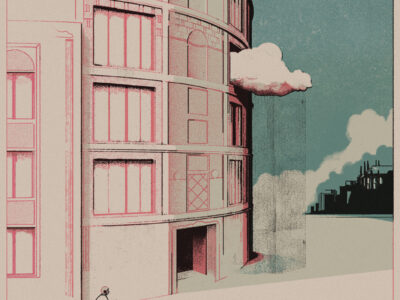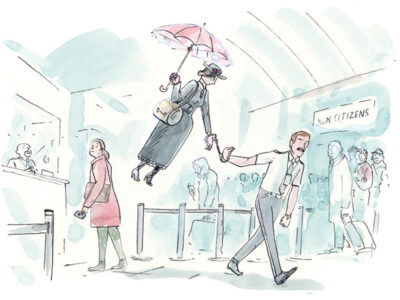
The history of Paraguay in a wood-powered locomotive.
St. John Barned-Smith | Sapucaí looked like any other Paraguayan campotown when I passed it on the bus the first time, on my way to the small village where I spent the last two years as a Peace Corps volunteer. It had two gas stations and a few thousand inhabitants living in low-slung stucco houses that sat on either side of a long, recently asphalted ribbon of pavement. In summer the droning whine of cicadas mixed with the bone-rattling clatter of 18-wheelers roaring by.
This area is something of an empty quarter in Paraguay. When its rail service stopped 12 years ago, many of its inhabitants moved to Asunción, or other cities and countries, in search of work. Even Caballero, the district capital where I worked on health and sanitation projects, looked like a ghost town out of old Westerns.
A closer look at Sapucaí revealed a strange memorial to this depopulation: a collection of pint-sized train locomotives and rail cars scattered about, rusting into decrepitude. Intrigued, I set out to learn about the town and its trains. What I discovered was an eerie reflection of Paraguayan history.
One of the first sights that greeted me was the chassis of a train sitting on tracks long-since covered with grass. It was rusted almost beyond recognition. So was an old railroad crane that reared up a few yards away. Its boiler had turned rust-brown, and the crane’s main shaft emerged from it like a stork’s beak. Behind the train yards I found my first locomotive, Encarnacion 151. It was painted black, sported the Paraguayan flag, and looked like it had rolled right out of 1875. But in Paraguay, wood-powered engines like this one had plied the railways until 2000.

A little history. The first person to rule Paraguay after it gained independence from Spain was a doctor of theology named José Gaspar Rodríguez de Francia. He would not be the country’s last dictator, but he was possibly its most bizarre. After taking office in 1814, he immediately set to work trying to turn Paraguay into a self-sufficient utopia. Dr. Francia, as he became popularly known, banned higher education and instituted mandatory interracial marriage. He consolidated power so completely that the nation’s Congress decreed his absolute control over the country for life. He sealed Paraguay’s borders and nationalized the possessions of the Catholic Church, for which he was promptly excommunicated. (On hearing the news, he reportedly said, “If the Holy Father himself should come to Paraguay I would make him my private chaplain.”)
Francia’s capricious leadership had an upside: It integrated Paraguay’s population and forced the country to develop its domestic economy. By the end of Francia’s reign, Paraguay had become one of the wealthiest countries in Latin America.
It was in this context that, in roughly the quarter-century following Francia’s death in 1840, two of his successors—Carlos Lopez and then Lopez’s son Francisco—set to modernizing the country. In 1856, they enlisted the help of an English engineer named William Whytehead to build the San Roque train station in Asunción. (The Lopezes also brought the country a modern navy, an opera, and South America’s first foundry.)
Within six years, Paraguay’s network of rails reached 45 miles into the jungle. The first train ran in 1861, a teacup-sized screecher named Sapucaí—in Guarani, “The Scream”—for its piercing whistle. It still sits in Asunción’s central station today.
The story in Paraguay goes that its trains were the first in South America. After talking to a local historian, I learned that was an exaggeration. But even if this benign legend may not be true, its persistence testifies to the train’s historical status as a symbol of national pride.
After paying the equivalent of one American dollar, I walked into Sapucaí’s old repair sheds, which were converted into a museum about a year ago. The site has been cleaned and re-roofed, allowing welcome sunlight to stream into the workshops, but other than that the place looked as if it had sat unchanged for the last 150 years.
David Martinez Zayas showed me around. A math teacher at Sapucaí’s high school, he sometimes leads tours at the museum.
“The technicians chose Sapucaí for its wood and water, which wouldn’t dry up,” David told me. A natural spring on top of one of the hills that ring the town fed Paraguay’s first running-water system.
At first, Paraguay relied on outside help to run its trains.
“If something was broke, they would have to send it to England,” David explained. “Finally, they said, ‘No. We can’t depend on England. We have to be able to repair things here.’”
Many of the people who used to work at the junction still live nearby. I visited Antonio Giménez, a former carpenter, early one Sunday morning. He met me fresh from his fields, where he had been tending his crops. The 73-year-old wore Macintosh rain boots and billowing brown pants, and had an easy smile. His shirt was plaid, and a straw hat crawled down over his ears. Giménez started working for the railroad in 1974 and continued there for 23 years.
This period was not an enviable time to be a Paraguayan—and it had been preceded by a century of protracted tragedies. The chapters in Paraguay’s history following the Lopezes’ era of modernization read like a concerted attempt to set a record for catastrophic statesmanship and dysfunctional governance. During the mid-1860s, Francisco Lopez led Paraguay into a war against the combined forces of Uruguay, Argentina, and Brazil. As much as 90 percent of Paraguay’s male population died. Several decades later, the country suffered through another brutal conflict, the War of the Chaco, against Bolivia. In the first half of the 20th century, the country had 31 presidents, most of whom were removed by force. And then the country underwent the darkness of el Stronato, when Alfredo Stroessner ruled Paraguay as his personal fiefdom from 1954 to 1989.
Stroessner made his mark on the country by disappearing his political opponents, enslaving indigenous tribal groups, and (allegedly) ordering his opponents chain-sawed to death to the strains of the Paraguayan polka.
In the early 1990s democracy finally returned to the country, yet many Paraguayans still regard Stroessner and his predecessors with an air of nostalgia. “Sure, there is more freedom now, but you could sleep in the streets back then if you wanted to, and nothing would happen to you,” was a not-uncommon refrain from some of the older generation in my village of Potrero Pucu.
Giménez was slow to talk about the train, and we were at cross purposes, talking in Guarani and Spanish while I tried to convert it all to English. But as our labored conversation gained steam, his pride in the trains became apparent. This railyard had been an institution of regularity and semi-modernity in a country that, at the time, was a pariah known for runaway corruption and human-rights abuses.
“The workshop was the biggest in Paraguay. It was the lung of the railway,” he said with feeling. “Here, we made everything and sent it to the other stations” in Asunción and San Roque.
Until the paved road on which I’d first passed Sapucaí was built in 2010, the only ways to reach the town had been by train or a 15-mile dirt track from the state capital of Paraguarí, Giménez told me.
“When it rained, buses wouldn’t come,” he said. “But the train never failed.”
He reminisced about the everyday rhythm of the place. Every morning a huge clock that hung at the train yards let out a blast an hour before work started. The workers stirred in their beds and soon rose to drink maté and sweet milk tea. A second blast sounded half an hour before work began. They hustled out of their houses to get to the yards, the clock whistling twice more as the beginning of the workday approached.
I asked him what he liked best, and he responded without even thinking. “My favorite thing was eating breakfast with my brother and my friends in the mornings,” he said. “It was like a big party. People went to sell things, they went for curiosity.”
And then the party ended. During the 1980s and ’90s, Paraguay shook itself free from its dictatorial past, but the rail service began getting cut. The trains hadn’t had any substantive modernization in the previous 140 years. They were still being pulled by wood-powered locomotives, and the workshops were still relying on steam. The rails themselves, which hadn’t been upgraded, began to wear out. When a gas-powered train carrying 60 wagons came through from Argentina, it went straight off the rails, I learned from Mario González, an amateur historian who lived in the area and also worked on the rails.
“They couldn’t handle the weight or the velocity of the train,” he said.
An accident outside of Asunción in 2000 killed two people and shut down the service, though the train occasionally ran in a limited capacity as late as 2004, carrying passengers and freight. There was talk of restoring and rejuvenating the line, González told me. The king of Spain visited, and pledged millions for the project, but it failed to materialize. Japan was also interested. “But they didn’t want to give money because of the corruption,” González said.
Meanwhile, in 2008, Paraguay elected Fernando Lugo president. His election marked the first peaceful transfer of power to an opposition party in the country’s history, and the first time the Colorado party—that of Stroessner—had lost an election in 61 years. And then, amid a storm of controversy earlier this year, its legislature impeached him.
This time, however, the government stayed in place and Lugo acquiesced peacefully. The republic survives, and in fits and starts the country churns along. But on the road past Sapucaí, the trains sit in a silent yard, awaiting their own uncertain fate.
St. John Barned-Smith C’08 was a Peace Corps volunteer in Paraguay from 2010 to 2012.




